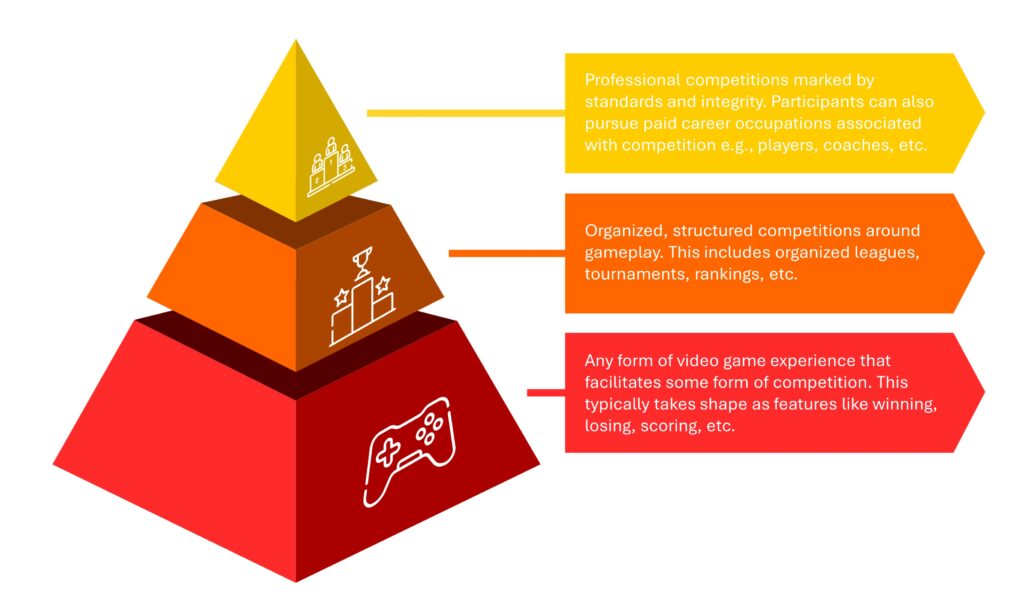This is the fifth part of a series covering terms core to effective gaming marketing strategies and campaigns.
The objective is to learn their meanings and gain insights that help navigate this dynamic space!
Please see part one here, part two here, part three here and part four here. Since those terms are mentioned below.
Target (gaming) audience
A target gaming audience is the population meant to perform an intended (target) action.
Where all gaming audiences are synonymous with their experience of some gaming behavior or behaviors. That means intended actions should be relevant to those behaviors.
Example
A video game environment is marked by the experience of gameplay behaviors. Where those who venture into that virtual world to play (players) are the target audience for in-game advertising placements.
Those advertising placements can inspire actions like awareness and consideration, as long as they do not interrupt gameplay.

Gaming media mix
The gaming media mix refers to the selection of media relevant to a target gaming audience. Where it combines the channels and platforms necessary to show up in spaces relevant to that audience.
Example
The media mix for a gaming campaign targeting esports fans would differ from a campaign seeking to connect with mobile gamers. Since those audiences frequent different game spaces.
Gaming marketing mix
The gaming marketing mix describes the strategic elements used to bring an offering to market for target gaming audiences.
The marketing mix takes shape as gaming-specific tactics across the traditional 4 P’s – product, price, place and promotion.
- Product: Key features and qualities which distinguish a product from alternatives
- Price: The cost to acquire the offering
- Place: Where the product should is available and how it will be displayed
- Promotion: The overall media strategy for introducing a product.
It includes all aspects of bringing a product to market, not just communication.
Example
Sanrio celebrated the 50th anniversary of Hello Kitty by partnering with Razer for an exclusive gaming gear collection. The collaboration demonstrated all four elements of the marketing mix.
- Promotion: The collection leveraged paid digital media, social media and PR
- Product: Hello Kitty branding on all peripherals (Razer Enki X gaming chair, Razer Kraken V2 BT wireless gaming headset, and Razer Ornata V3 TKL mechanical keyboard)
- Price: All Hello Kitty hardware is functionally identical to its standard counterpart but is more expensive e.g., the standard Kraken Kitty V2 is currently $79.99, whereas the Hello Kitty model is $139.99
- Place: The peripherals can be purchased directly from Razer or through third party merchants like Amazon and Best Buy

Esports marketing
ChatGPT describes electronic sports (esports) as, “organized, competitive video gaming where individuals or teams compete against each other in various video games.“
In other words, esports are an umbrella term for competitive video game behaviors. These behaviors are distinct from, but dependent on, gameplay.
Esports can be pictured as a three layer pyramid of competitive game experiences.
Communication designed to inspire action through relevance to any of those layers is esports marketing.

Example
DoorDash presented the third year of “Battle of the Brands,” in 2023. The two-day livestream MultiVersus gaming tournament, pitted 10 restaurant brands like Taco Bell and Burger King against one another, each represented by a video game streamer of their choice.
Warner Bros. Games’ MultiVersus is a fighting game title that pits players against each other in head-to-head battles (first layer). DoorDash sponsored the organized tournament (second layer).
The presence of $35,000 in cash and prizes is a feature of professional gaming (third layer). However, the tournament is not considered a professional tournament on par with something like the League of Legends Worlds Championship.

Also, remember to subscribe to our YouTube channel to keep up with the latest gaming marketing insights and trends!

